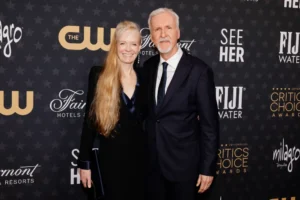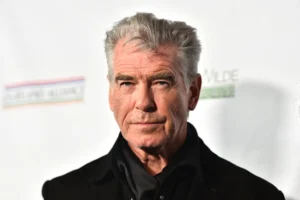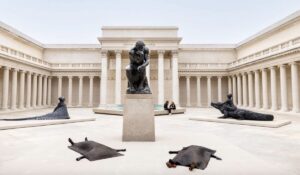If we’re being honest, 2021 hasn’t been any better than 2020. Any hopes of “normalcy” were dashed as the alphabet of COVID-19 variants grew longer. As the pandemic raged, the political sphere erupted in chaos, workers across the globe took a stand against exploitation, and we were forced to learn what NFTs are.
Hyperallergic journalists spent the year reporting on the stories most pressing in the cultural sector, from the January 6 Capitol attack to a stall on the Sacklers’ ability to artwash their reputations through philanthropy.
Staff reporters Hakim Bishara and Valentina Di Liscia, along with contributors like Sarah Rose Sharp and Cassie Packard, have worked diligently throughout the difficult year to keep readers up to date. As our publication’s scope has grown, so has our newsroom, with staff reporter Jasmine Liu joining just last week. I can assure you that as we enter the new year, these writers, and the greater pool of talented contributors we work with, will keep you up to date with all of the latest happenings in the cultural sector.
For now, we’ve rounded up the 15 biggest art stories from this whirlwind of a year. Let’s just hope that 2022 brings better news. —Jasmine Weber, News Editor
NFTs
Beeple, “EVERYDAYS: THE FIRST 5000 DAYS,” the first the first purely digital artwork (NFT) being offered by Christie’s. (image courtesy of Christie’s Images Ltd. 2021)
In the time warp that is the news cycle since 2020, it may seem as though non-fungible tokens (NFTs) emerged on the scene ages ago. In reality, just a few months ago, we were asking questions like “what, exactly, is an NFT?” (Short answer: it’s a unique digital artwork that is created or “minted” on a blockchain, mainly Ethereum, where it can be traded and sold. But truthfully, many of us are still not sure.) The conversation was immediately divided into those who tout NFTs as a democratic alternative to a gatekeeping art world, and those who questioned their potential for change and their environmental impact. Carbon offsetting became a popular way for NFT marketplaces and artists to temper concerns over their CO2 emissions, but critics said these fail to address NFT’s ecological footprint. And while artists like Beeple and other multimillion-dollar beneficiaries of the NFT craze made big headlines, a recent study found that 75% of NFTs sell for an average of $15 — and only 1% sell for over $1,594 — bursting the bubble (no pun intended) of crypto art’s revolutionary potential. —VD
Repatriation & Restitution
“Warrior Chief” (16th–17th century), a brass sculpture in the Metropolitan Museum of Art’s collection that is being repatriated to Nigeria. (image courtesy the Metropolitan Museum of Art)
This year has seen the long-awaited realization of French President Emmanuel Macron’s promise to return 26 objects to Benin. In the years since the plan was first outlined, the cultural artifacts — a set of over 1,000 bronze and brass heads, sculptures, and plaques that were looted from Benin’s royal palace by the British — have come under intense examination for their presence in museums worldwide. This year, Germany announced it would return all its bronzes in 2022, and the Netherlands set its sights even higher: it laid out a plan to return any objects stolen from a former Dutch colony, “unconditionally.” And this summer, the Met returned two brass plaques, though it still holds approximately 160 Benin Bronzes in its collection. A glaring omission? The British Museum, which owns the lion’s share of Benin Bronzes, and has yet to budge on the matter. In September, a group of Nigerian artists made the British Museum a provocative and attractive offer: return the bronzes to Nigeria, and we’ll give you our contemporary pieces — which, by the way, we think are better. Now, more than ever, the ball is in the British Museum’s court on repatriation issues: last month, the British government backed down from its longstanding position that the Parthenon Marbles were “legally acquired,” with a Boris Johnson spokesperson saying that the ownership of the marbles was a matter for the museum and not the state.
Meanwhile, Germany’s advisory commission on Nazi-looted art, first established in 2003, continues to steadily issue new recommendations. Of note, it urged the restitution of a Franz Marc painting to the heirs of Kurt Grawi, a Jewish banker who sold the painting in New York to fund his emigration from Nazi Germany. That determination came with some dissent and expanded accepted notions of what constitutes a “sale made under duress.” Comparably, the City of Amsterdam returned a Kandinsky painting to the heirs of Robert Lewenstein and Irma Klein, who faced financial hardship in the 1940s due to persecution and Nazi occupation — despite an earlier ruling that the circumstances did not warrant restitution. Finally, in November, a Van Gogh painting Meules de blé (“Stacks of wheat”) fetched $35.8 million at auction, the first time it was seen by the public since 1905 and a world auction record for a Van Gogh. Its sale will help provide financial restitution to the heirs of two Jewish collectors — one who sold the painting to escape Nazi Germany and another who had it stolen from her by the Nazis. Each of these cases have subtly shifted the contours of what contexts warrant restitution: not only blatant theft, but also conditions of racial and religious discrimination and persecution. —JL
Unionization
A masked Guerilla Girls member shows support for the MFA Boston strike with a sign reading “Hey MFA; Pay your staff a living wage — XOXO, Guerilla Girls” (photo by and courtesy Rosemary Taylor)
2021 has been a pivotal year for workers, with strikes happening across the United States, from John Deere to Kellogg. The labor movement has certainly not missed the art world, with workers from museums across the country filing votes in favor. This momentum has been building at museums over several years, but the pandemic has only exacerbated the urgency for a transformation of conditions, especially after the layoffs and furloughs that affected thousands of art workers at the start of the pandemic. At the Guggenheim, after years of protests over stalled and strained negotiations, its unionized art handlers and facilities staff came to an agreement with the museum. In November, MFA Boston workers from across departments went on strike for a day, saying leaders stalled on implementing layoff protections or reasonable salary increases. The institution-wide solidarity among workers has been an increasing theme, with all-staff unions also forming at the Brooklyn Museum and Whitney Museum. For those in need of guidance in their efforts, a collective of Bay Area artists even released an A-Z guide to launching a museum union. —JW
Climate Change
A pixel art polar bear on a melting ice cap (illustration by Jasmine Weber for Hyperallergic)
With its art fair jet-setters and environmentally-costly installations, the proverbial art world has been criticized for its complicity in the climate crisis long before NFTs began expelling little clouds of smoke every time they’re minted on the blockchain (okay, that’s not what actually happens, but it’s definitely how I picture it). This year, climate change activists such as the group BP or Not BP? amped up pressure on UK museums to drop Big Oil sponsorship, exposing the disconnect between climate-themed exhibitions and institutions’ less-than-green sources of funding. Meanwhile, researchers found that cave paintings are deteriorating faster due to monsoonal rains and worsening droughts, and the World Monuments Fund identified climate change as one of three key factors disproportionately threatening cultural sites. In the era of COVID-19, the intersection of art and science has also yielded fascinating creations and discoveries: photographer Şebnem Coşkun captured the distressing build-up of PPE and other pandemic waste in our oceans in her award-winning underwater image, while artist Marianne de Groot-Pons tackled the problem head-on, designing biodegradable face masks filled with flower seeds that bloom when discarded. And in one of the year’s quirkiest stories, a team of scientists in Indiana created a white paint that reflects solar radiation in order to combat global warming, earning a Guinness World Record title in the process. —VD
Monuments
The contentious statue of Robert E. Lee on Richmond’s Monument Avenue no longer stands. (via Flickr)
In regard to the heated debate about racist public statues, steam from efforts initiated in 2020 rolled over into this one. Pending lawsuits against the removal of the largest Confederate monument in the South — an imposing bronze statue of Lee on horseback in Richmond, Virginia — were waved away by the state Supreme Court, and when the statue came down, crowds chanted “Hey, hey, hey, goodbye!” (It’s unclear what will happen to the base of the statue, which has become a focal site of reclamation for activists who have covered it with protest slogans and the names of victims of police violence.) And a large, imperialist statue of Theodore Roosevelt on horseback flanked by an African man and a Native American man, marking the entrance of the American Museum of Natural History since 1940, is finally being removed. Still, there’s more reckoning to be had on what the role of public monuments should be in commemorating our collective history: an audit of 50,000 monuments across every state and territory showed that, to no great surprise, monuments are disproportionately white and male and overwhelmingly honor war and conquest. What could monuments do if unburdened of their racist, chauvinistic, and violent associations? —JL
Anti-racist Activism
“Justice for George” spray-painted on a panel at Saint Clair Avenue in Saint Paul, Minnesota (photo by and courtesy Heather Shirey)
As historic Black Lives Matter (BLM) protests swept the country last year, some museums and institutions posted empty messages of solidarity on social media and went about business as usual. But while they talked the talk, many other organizations, artists, and cultural workers actually walked the walk, as evinced by the wave of anti-racist activism that permeated every sector of the arts this year. Among the most hopeful messages to emerge in this period came in the form of street art, and researchers from the University of St. Thomas in Minneapolis created a database to record and map the graffiti, murals, and projections surfacing worldwide. As anti-Asian prejudice continued to rise during the pandemic, StopDiscriminAsian (SDA), a group of Asian diasporic artists and arts workers, ramped up their efforts to combat a surge in hate crimes and violence against the community. In the wake of a brutal hate crime in Atlanta, they gathered hundreds of signatures from cultural figures in an open letter denouncing white supremacy. Artist Amanda Phingbodhipakkiya’s poignant tribute to the six Asian women who were murdered graced the cover of TIME. On the institutional front, the Brooklyn Public Library’s Center for Brooklyn History launched a new research initiative examining six decades of Black-led activism in the borough, inaugurated on Juneteenth, and the Noguchi Museum in Queens transformed its outdoor banners into anti-racist symbols with designs by Chemin Hsiao. —VD
Strike MoMA
Over 200 protesters held space at MoMA’s entrance (photo by Hrag Vartanian/Hyperallergic)
This March, a coalition of activists and artists announced a series of protests against the Museum of Modern Art (MoMA), gathering dozens and sometimes hundreds of participants outside the Manhattan museum every Friday for 10 weeks. Under the banner of “Strike MoMA,” they exposed what they view as the institution’s complicity in global human rights and environmental abuses through the business dealings of their board members — from trustees Steven Tananbaum, Leon Black, and Paula Crown’s ties to Israeli violence against Palestinians, to the Cisneros family’s links to mining in the Dominican Republic. MoMA’s leadership responded primarily with silence, though an email from Director Glenn Lowry to staff that was leaked to Hyperallergic mischaracterized the protests and downplayed attendance. (Meanwhile, hundreds of artists and scholars including Angela Davis and Fred Moten signed an open letter denouncing MoMA’s “entanglement with the mutually reinforcing projects of settler-colonialism, imperialism, and racial capitalism,” and artist Gabrielle L’Hirondelle Hill withdrew from programming at the museum in solidarity.) For the last week of protests, over two hundred demonstrators marched through Midtown Manhattan, stopping at key sites related to the implicated board members’ sources of wealth. Why strike MoMA? “So that something else can emerge,” the group said in a letter to Lowry. “Something controlled by workers, communities, and artists rather than oligarchs.” —VD
Stimulus
On the one-year anniversary of the WHO’s official declaration of COVID-19 as a pandemic, Biden signed the American Rescue Plan into law on March 11, 2021. It included a $470 million outlay for relief to arts and culture organizations, $135 million of which was allocated to the National Endowment for the Arts (NEA) and the National Endowment for the Humanities (NEH). That represented a significant boost from the meager $75 million set aside by the Trump administration’s relief bill a year before — a figure that, despite being wholly lackluster, was still better than appropriating absolutely no federal arts funding, a budget proposal Trump crusaded for every year of his presidency. Meanwhile, museums, music venues, theaters, and independent cinema are just getting back on their feet if they’ve survived the pandemic at all. —JL
Occupied Palestinian Territories
“DEFEND JERUSALEM, DEFEND PALESTINE” (photo courtesy the Illuminator, Decolonize This Place, and Within Our Lifetime)
This year, an outbreak of violence in the Occupied Palestinian Territories, catalyzed by a spike in Israeli violence in Sheikh Jarrah, directed the world’s attention to the struggle of Palestinians. Against the Manhattan skyline, artist-activists projected messages of solidarity calling for “All Eyes on Palestine.” Over 16,000 signed a letter written by six anonymous Palestinian writers, urging cultural workers to “exercise their agency within their institutions and localities to support the Palestinian struggle for decolonization.” The missive was signed by an unprecedented number of cultural figureheads, including Yto Barrada, Ta-Nahesi Coates, and Kara Walker. Likewise, thousands of Canadian cultural workers and artists signed a petition urging the country’s institutions to “end any form of collaboration with Israeli state-financed and sponsored art and cultural activities with Israel.” The occupation was also a central theme in Strike MoMA; in May, Angela Davis and Fred Moten were among hundreds of artists and scholars condemning the museum’s connections to violence against Palestinians. —JW
Leon Black
If the name “Leon Black” does not fill you with a profound sense of dread, you have some catching up to do. Earlier this year, the disgraced financier stepped down from his role as board chairman at the Museum of Modern Art after more than 150 artists demanded his removal, citing his financial and personal ties to the late sex offender Jeffrey Epstein. Black resigned as CEO of his private equity firm Apollo Global Management in the wake of a company review that found he paid Epstein $158 million for advice on tax issues, estate planning, and his art collection. Though no longer chairman at MoMA, replaced by Marie-Josée Kravis, who is the vice-chair of a conservative think tank, Black remains a trustee (cue upside-down smiley emoji). This is despite the fact that artists included in MoMA PS1’s Gulf Wars exhibition confronted the museum over the separate issue of Black’s investments in defense contractors tied to civilian murders in Iraq; or that Black has more recently been accused of sexual abuse and sued for defamation by former model Guzel Ganieva; or that Dartmouth University students also called for the school’s Leon Black Arts Center to be renamed…Just another day in the art world, folks. —VD
Sacklers
The Sackler family — shameful architects of the marketing and development of OxyContin and chief beneficiaries of an opioid epidemic that has claimed the lives of over 500,000 Americans — reached a settlement last year with the Department of Justice that will require them to pay $4.5 billion over the next nine years. (If that feels like a hefty sum to you, it’s not for them: their net wealth is estimated at $13 billion.) Notably, that figure doesn’t come close to measuring up against the costs of the epidemic. And the same settlement, egregiously, releases the Sacklers themselves from any legal liability. The latest settlement also bans the Sacklers from plastering their name on any more institutions in the United States — but only for the next nine years. In August, Prescription Addiction Intervention Now (PAIN) activists — who have raised awareness around the Sacklers’ propagation of harm and artwashing since 2017 — staged a protest at the US Bankruptcy Court in White Plains, New York. Led by photographer Nan Goldin, they displayed a poster lampooning the “morally bankrupt bankruptcy court” and scattered prescription bottles and dollar bills with the word “Oxy” around the courtyard garden, which they had peppered with tombstones. They haven’t let the Sacklers’ intimidation tactics, which involve hiring private investigators to follow activists and journalists around, scare them into silence. Meanwhile, legislators are looking into how legal protections might be installed for museums and other nonprofits who choose to ditch the Sackler name. —JL
Artsakh
Images showing the destruction of Sghnakh cemetery in Nagorno-Karabakh due to road construction (image courtesy the Caucasus Heritage Watch)
In 2020, Armenian cultural heritage in Artsakh came under flagrant attack, with the Nagorno-Karabakh war raging. Despite a ceasefire, millennia of Armenian culture remain at-risk; this summer, Caucasus Heritage Watch utilized satellite imagery to identify over a dozen Armenian sites that have been destroyed, damaged, or threatened by Azerbaijan. Hyperallergic’s coverage of such cultural destruction reaches back years, but this February, Artsakh was the subject of a special Sunday edition, to which scholars contributed their research on Armenian artistic contributions now under siege. Notably, Nevdon Jamgochian deep-dived into Azerbaijan’s oft-successful campaigns of artwashing its global image by inviting international artists, and Yelena Ambartsumian answered “why Armenian cultural heritage threatens Azerbaijan’s claims to Nagorno-Karabakh.” In an introductory essay by Hyperallergic editor-in-chief Hrag Vartanian, he wrote “The event may be the largest cultural genocide of the 21st century.” —JW
January 6
A wide range of flags, including Blue Lives Matter, Texas, and the classic “Don’t Tread on Me” banners, were among the sea of visuals on January 6. (photo by Bucky Turco and used with permission)
Six days into the new year, Republicans in Congress lodged cynical complaints about the election — despite impartial consensus that it was fraud-free — and Trump goaded his extremist base to march to the Capitol to “take back our country.” What resulted was exactly what Trump prescribed: a paramilitarized assault on democracy by a motley crew of white supremacist, conspiracy groups. Almost a year out, the event remains as bizarre, disconcerting, and depressingly predictable as it was the day it took place. Eyewitness blogger Bucky Turco shared with Hyperallergic some stark, absurd details to supplement the carnivalesque images that have quickly become ingrained in our collective consciousness: young children ran “up and down the steps of the Capitol… as their parents chanted like drones and took photos,” and a rioter obeyed orders to put out his cigarette despite taking part in a literal insurrection. Capitol curators had to request $25,000 in funding to repair art damaged as a result, representing just one aspect of the restorative work our country needed to undertake to move forward from that fateful day. —JL
Free Renty
The daguerreotypes of Tamara Lanier’s enslaved ancestors housed at Harvard University’s Peabody Museum were commissioned by Louis Agassiz in 1850 to substantiate his discredited theories of White biological superiority. Lanier invoked these horrific circumstances and her genealogical ties to those depicted, Renty Taylor and his daughter Delia, when asking Harvard to hand over the photographs — but the university was unswayed. Instead, Harvard has continued to fervently defend its ownership of the images in an ongoing lawsuit that could influence US cultural property legislation and even reparations for Black Americans. In advance of oral arguments heard at the Massachusetts Supreme Court on November 1, Hyperallergic published a special edition on the #FreeRenty movement, including 12 scholarly endorsements of Ariella Aïsha Azoulay’s amicus brief in favor of returning the daguerreotypes to Lanier. —VD
COVID-19
An image of Raphael donning a face mask, from Hyperallergic’s 2020 “Daily Report on How COVID-19 Is Impacting the Art World” (edit by Jasmine Weber for Hyperallergic)
We can’t close out this list without acknowledging the dark cloud that’s been looming over our heads for nearly two years: the COVID-19 pandemic. Thanks to the diligence of scientists worldwide, this year saw a major vaccine rollout. But the pandemic is far from over, and uneven global distribution of the life-saving inoculation, coupled with closed patents, only served to further the pandemic’s damage.
For most museums, there was an unsurprising plummet in attendance. But a survey by the Association of Art Museum Directors showed that while many of the lowest-ranking staffers at museums bore the brunt of this squeeze via decreased salaries and job insecurity, many of the highest-paid officials saw upticks in their annual take home. Here in New York, which was one of many cities around the world to implement a vaccine mandate for indoor cultural outings, two installations at the Elmhurst Hospital in Queens — at a point the “epicenter of the epicenter” of the pandemic in the US — acknowledged the hospital’s staff and patients. The Centers for Disease Control and Prevention (CDC) launched an art-forward vaccination campaign, especially focusing on developing relationships between state and local health departments and artists in their own communities.
For those who are able, go out and get your booster — to keep yourself and your community safe, and so that next year, Hyperallergic’s year-end may have a less dire conclusion. —JW
Now that you’ve made it through the year in news, we invite you to take a break by looking at some of the internet’s most vital content: cat posts. The topic proves to be Bishara’s cuddliest beat, writing on eerily realistic AI kitties, feline beauty rankings, and bodega cats. We promise it’ll lighten your mood. —JW
















+ There are no comments
Add yours